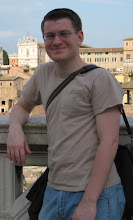 As the picture above shows, the museum stands at the end of Wenceslas Square in Prague. For those who plan to visit Prague some day, the square is really more of a short boulevard. The square is a significant tourist destination and is also where the four major metro lines intersect, so it is perpetually bustling.
As the picture above shows, the museum stands at the end of Wenceslas Square in Prague. For those who plan to visit Prague some day, the square is really more of a short boulevard. The square is a significant tourist destination and is also where the four major metro lines intersect, so it is perpetually bustling. Museums often act as alternative classroom location for school-age students, especially students in publicly run schools.Most of us can probably recall a myriad of museum visits from our early childhood. Museums are aware of this and design many of their exhibits in ways that reach younger children as well as adults. Sometimes, museums exhibits seem to have been designed for school children entirely. In the National Museum, one such example was the exhibit on feet.
Museums often act as alternative classroom location for school-age students, especially students in publicly run schools.Most of us can probably recall a myriad of museum visits from our early childhood. Museums are aware of this and design many of their exhibits in ways that reach younger children as well as adults. Sometimes, museums exhibits seem to have been designed for school children entirely. In the National Museum, one such example was the exhibit on feet.  That is, as far as we could figure out, feet is what it was designed around. All of the writing was in Czech and it included an eclectic mix of artifacts and practices tangentially related to feet. The exhibit's appeals to children included a giant foot that had to be walked through to enter the exhibit and an anthropomorphized, cartoon foot who appeared to be narrating our journey through the world of feet. On the left, a speechless Jessica stands beneath the bewildering foot-shaped entrance and on the right, the cartoon foot leads the way for visitors.
That is, as far as we could figure out, feet is what it was designed around. All of the writing was in Czech and it included an eclectic mix of artifacts and practices tangentially related to feet. The exhibit's appeals to children included a giant foot that had to be walked through to enter the exhibit and an anthropomorphized, cartoon foot who appeared to be narrating our journey through the world of feet. On the left, a speechless Jessica stands beneath the bewildering foot-shaped entrance and on the right, the cartoon foot leads the way for visitors.Not all of the museum appeared to be designed with children in mind. The geology and zoology exhibits included large rooms with rows of cases filled with specimens. These rooms were drab and the cases held little more information than the name of the specimen on display. They were difficult to appreciate for me as an adult and so I moved through them relatively quickly. I think that it is safe to say that few children would find them stimulating.
 A particularly interesting part of the museum was labeled "The Pantheon." Upon entering, Jessica and I grabbed a map and immediately noticed this room. "Great," we thought to ourselves, "it will be interesting to see an exhibit on a place that we have so recently visited in Rome." This pantheon, was not an exhibit on The Pantheon, but rather a room with busts of the great people of Czech dissent. There were the obligatory busts of Dvorak, and Neruda. Havel has not made it yet. None of the members of the pantheon were living. This room was fascinating because, in the same way as we have created a pantheon out of groups of people like the "founding fathers," this place clearly marks-out those Czechs from history who are to be valued and imitated. Of course, those designations carry with them a set of values. I am not equipped with the requisite understanding of Czech history to evaluate the values being upheld in each bust, but from what I did see that I know of, contributions to the Czech state and culture seemed to be valued highly.
A particularly interesting part of the museum was labeled "The Pantheon." Upon entering, Jessica and I grabbed a map and immediately noticed this room. "Great," we thought to ourselves, "it will be interesting to see an exhibit on a place that we have so recently visited in Rome." This pantheon, was not an exhibit on The Pantheon, but rather a room with busts of the great people of Czech dissent. There were the obligatory busts of Dvorak, and Neruda. Havel has not made it yet. None of the members of the pantheon were living. This room was fascinating because, in the same way as we have created a pantheon out of groups of people like the "founding fathers," this place clearly marks-out those Czechs from history who are to be valued and imitated. Of course, those designations carry with them a set of values. I am not equipped with the requisite understanding of Czech history to evaluate the values being upheld in each bust, but from what I did see that I know of, contributions to the Czech state and culture seemed to be valued highly.I am forced to wonder if the pantheon is designed to serve adults, children, or both. That is, are children brought through the room when they visit? It seems that such visits might be sites of cultural education that begins at a very young age.



No comments:
Post a Comment